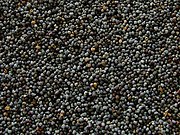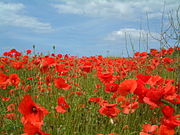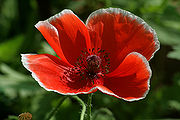Poppy
This article needs additional citations for verification. (May 2011) |
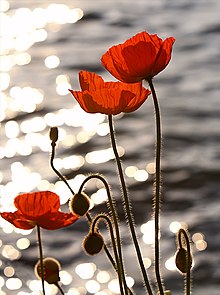

A poppy is one of a group of a flowering plants in the poppy family, many of which are grown in gardens for their colorful flowers. Poppies are sometimes used for symbolic reasons, such as in remembrance of soldiers who have died during wartime.
Poppy flowers have 4 to 6 petals. The petals may be almost any color, and some have markings. Before blooming, the petals are crumpled in the bud, and as blooming finishes, the petals often lie flat before falling away. A whorl of stamens is in the center of the flower.
The pollen of the oriental poppy, Papaver orientale, is dark blue. The pollen of the field poppy or corn poppy (Papaver rhoeas) is dark blue to grey. Bees use poppies as a pollen source.
Poppies belong to genera of Papaveraceae, which includes:
- Papaver – corn poppy, Opium poppy, Oriental poppy, Iceland poppy, and about 120 other species
- Eschscholzia – California poppy and relatives
- Meconopsis – Welsh poppy, Nepal poppy, and relatives
- Stylophorum – Celandine poppy or wood poppy
- Argemone – Prickly poppy
- Romneya – Matilija poppy and relatives
- Canbya – Pygmy poppy
- Stylomecon – Wind poppy
- Arctomecon – Desert bearpaw poppy
- Hunnemannia – Tulip poppy
- Dendromecon – Tree poppy
Uses

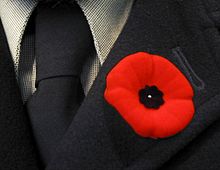
Most species of poppies are attractive and are cultivated as ornamental plants. A few species have other uses, principally as sources of drugs and foods. The opium poppy (Papaver somniferum) is so widely used, for both drugs and food, that its worldwide production is monitored by international agencies. It yields opium and opiates, poppy seeds for use in cooking and baking, and poppyseed oil for culinary and other uses, and is also cultivated as an ornamental plant.
Symbolism
Poppies have long been used as a symbol of both sleep, peace and death: sleep because of the opium extracted from them, and death because of the common blood-red color of the red poppy in particular. In Greek and Roman myths, poppies were used as offerings to the dead.[1] Poppies used as emblems on tombstones symbolize eternal sleep. This symbolism was evoked in the children's novel The Wonderful Wizard of Oz, in which a magical poppy field threatened to make the protagonists sleep forever.[1]
A second interpretation of poppies in Classical mythology is that the bright scarlet colour signifies a promise of resurrection after death.[2]
The poppy of wartime remembrance is Papaver rhoeas, the red-flowered corn poppy. This poppy is a common weed in Europe and is found in many locations, including Flanders, the setting of the famous poem "In Flanders Fields," by the Canadian surgeon and soldier John McCrae. In Canada, the United Kingdom, Australia, South Africa and New Zealand, artificial poppies (plastic in Canada, paper in the UK, Australia, South Africa and New Zealand) are worn to commemorate those who died in war. This form of commemoration is associated with Remembrance Day, which falls on November 11. In Canada, Australia and the UK, poppies are often worn from the beginning of November through to the 11th, or Remembrance Sunday if that falls on a later date (November 13 in 2011). In New Zealand and Australia, soldiers are commemorated on ANZAC day (April 25),[3] although the poppy is still commonly worn around Remembrance Day. Wearing of poppies was once a custom in the United States as well, and attempts have been made to revive the tradition in the US in connection with Memorial Day (end of May).[4][5]
Medical uses
Ancient Egyptian doctors would have their patients eat seeds from a poppy to relieve pain. Modern science tells us why this worked: poppy seeds contain both morphine and codeine, excellent pain-relieving drugs that are still used today.
Other uses
The California poppy, Eschscholzia californica, is the state flower of California.
In Mexico, Grupo Modelo, the makers of Corona beer, used red poppy flowers in most of its advertising images until the 1960s.
A poppy flower is depicted on the reverse of the Macedonian 500 denars banknote, issued in 1996 and 2003.[6]
The powerful symbolism of Papaver rhoeas has been borrowed by various advocacy campaigns, such as the White Poppy and Simon Topping's black poppy.
The girl's given name Poppy is taken from the flower.
Poppies (Amapolas in Spanish) are commonly featured as the central flower in Puerto Rican weddings.
Artificial poppies (called "Buddy Poppies") are used in the veterans' aid campaign by the Veterans of Foreign Wars, which provides money to the veterans who assemble the poppies and various aid programs to veterans and their families.[7]
Canada issued special quarters (25-cent coins) with a red poppy on the reverse in 2004, 2008 and 2010. The 2004 Canadian "poppy" quarter was the world's first coloured circulation coin.[8]
Gallery
-
Opium poppy (Papaver somniferum)
-
Opium poppy seed capsule
-
Opium poppy (Papaver somniferum) seeds
-
Field of poppies, by Sergei Mikhailovich Prokudin-Gorskii, c. 1912
-
White poppy seeds. There are about 140,000 poppy seeds to the ounce.<ref>Dr. Hutchins, R. E. 1965. The Amazing Seeds. New York: Dodd, Mead and Company/ref>
-
California poppy seeds
-
Red poppy flower
See also
- Heroin
- In Flanders Fields
- Morphine
- Papaver rhoeas
- Poppy goddess
- United Nations Office on Drugs and Crime
- White poppy (symbol)
References
- ^ a b L. Frank Baum, Michael Patrick Hearn, The Annotated Wizard of Oz, p. 173, ISBN 0-517-500868
- ^ Robert Graves, The Greek Myths, 24. 15 p. 96, ISBN 0-14-001026-2
- ^ Graham Seal (2004). Inventing Anzac: the digger and national mythology. Univ. of Queensland Press. pp. 105–. ISBN 9780702234477. Retrieved 18 September 2010.
- ^ World Book; Inc (2003). The World Book dictionary. World Book .com. pp. 1622–. ISBN 9780716602996. Retrieved 18 August 2010.
{{cite book}}:|author2=has generic name (help) - ^ United States of America Congressional Record. Government Printing Office. pp. 10121–. GGKEY:8F7NFQJ525R. Retrieved 18 August 2010.
- ^ National Bank of the Republic of Macedonia. Macedonian currency. Banknotes in circulation: 500 Denars (1996 issue) & 500 Denars (2003 issue). – access date 30 March 2009
- ^ Veterans of Foreign Wars Buddy Poppy Website
- ^ Canadian Poppy Coins



